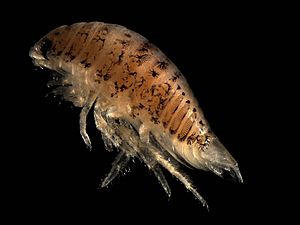Isopod facts for kids
Quick facts for kids IsopodaTemporal range: Carboniferous (300 - 0 Ma)
|
|
|---|---|
 |
|
| Eurydice pulchra (Cirolanidae) | |
| Scientific classification | |
| Kingdom: | |
| Phylum: | |
| Subphylum: | |
| Class: | |
| Subclass: |
Eumalacostraca
|
| Superorder: |
Peracarida
|
| Order: |
Isopoda
Latreille, 1817
|
| Suborders | |
|
|
Isopods are a group of small creatures called crustaceans. This group includes familiar animals like woodlice, often found in gardens. Isopods can live in many places: in the sea, in fresh water, or even on land.
These amazing animals have a hard, segmented outer shell, which is like their skeleton on the outside. They also have two pairs of antennae (feelers) and seven pairs of jointed legs on their main body part, called the thorax. On their lower body, or abdomen, they have five pairs of special parts that help them breathe. Female isopods carry their babies in a special pouch under their thorax until they are ready to hatch.
Isopods eat different kinds of food. Some isopods are like nature's clean-up crew, eating dead plants and animals. Others are grazers, munching on plants, or filter feeders, straining tiny bits of food from the water. A few isopods are predators, hunting other small creatures. Some are even parasites, living on or inside other animals, especially fish.
Where Isopods Live
Most aquatic (water-dwelling) isopods live on the seabed or at the bottom of lakes and rivers. However, some types can swim short distances. Land-dwelling isopods usually crawl around and prefer cool, damp places. You might find them under rocks, logs, or leaves. Some species can even roll themselves into a tight ball. This helps them stay safe from danger and also keeps them from drying out.
There are over 10,000 different kinds of isopods around the world! About 4,500 species live in the ocean, mostly on the seafloor. Around 500 species live in fresh water, and another 5,000 species live on land. We know isopods have been around for a very long time. Their fossils show they lived in shallow seas at least 300 million years ago, during a time called the Carboniferous period.
Life on Land
Most crustaceans live in water, but isopods are one of the few groups that have successfully moved onto land. Other crustaceans with some land-dwelling members include amphipods (like sandhoppers) and decapods (like crabs and shrimp).
Land isopods, especially woodlice, are very important in many ecosystems, from tropical forests to temperate gardens. They help break down dead plant material, which is a key part of recycling nutrients in nature. They also help tiny microbes (like bacteria and fungi) do their job. Woodlice, which belong to the suborder Oniscidea, are the most successful group of land crustaceans. They have developed many special adaptations to survive away from water.
Isopods can lose water easily from their bodies, especially from their underside, because they don't have a waxy coating like insects do. To stay hydrated, they often live in humid places. They might hide under stones, tree bark, or leaf litter. Isopods that live in deserts are usually active at night. They spend the hot day in underground burrows and come out when it's cooler. They get water from their food or by drinking. Some species can even use special parts on their tail, called uropods, to funnel water from dewdrops onto their breathing organs.
Many isopods can roll into a ball when they feel threatened. This defense behavior also helps them save moisture. Some types, like rock lice or sea slaters (from the families Ligiidae and Tylidae), are not as specialized for land life. They live in the "splash zone" on rocky shores, jetties, and piers. They might hide under debris washed up on the shore and can even swim if they fall into the water.
Related pages
Images for kids
-
The woodlouse Oniscus asellus showing its head with eyes and antennae, body, and legs.
-
An Anilocra isopod (Cymothoidae) living as a parasite on a fish called Spicara maena in Italy.





